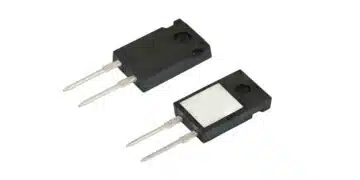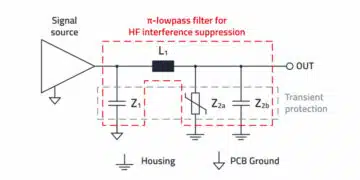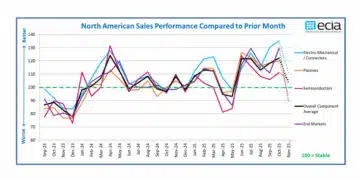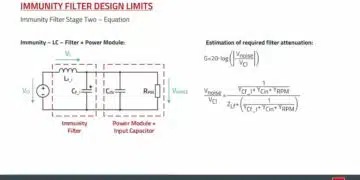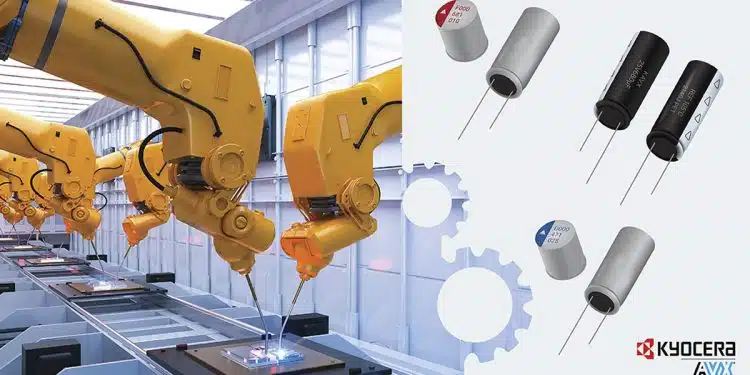KYOCERA AVX new range of radial-leaded aluminum electrolytic capacitors includes wet, conductive polymer, and hybrid aluminum electrolytic capacitors with commercial and industrial reliability levels and competitive pricing, and it offers a comprehensive selection of CV values and cases sizes with one of the shortest lead times of any competing capacitor available on the market.
KYOCERA AVX, a leading global manufacturer of advanced electronic components engineered to accelerate technological innovation and build a better future, released an extensive new range of radial-leaded aluminum electrolytic capacitors engineered for use in industrial, communications, and consumer electronics applications and available with a 24-week lead time, which is currently one of the shortest lead times of any competing capacitor on the market.
The new radial-leaded range is comprised of REH, REF, and REH Series wet aluminum electrolytic capacitors, RPA and RPF Series conductive polymer aluminum electrolytic capacitors, and RHA and RHD Series hybrid aluminum electrolytic capacitors and offers a wide variety of part numbers with commercial and industrial reliability levels and competitive pricing.
- REA Series radial-leaded wet aluminum electrolytic capacitors exhibit high endurance (3,000–5,000 hours at 105°C) and deliver long-lifetime performance in applications including communications and industrial equipment. They are available with 28 capacitance values extending from 0.47µF to 22mF ±20%, 14 voltage ratings extending from 6.3VDC to 450VDC, and two rated operating temperature ranges: -40°C to +105°C for 6.3–250V parts and -25°C to +105°C for 350–450V parts. They are also RoHS compliant and lead-free compatible.
- REF Series radial-leaded wet aluminum electrolytic capacitors exhibit low impedance, high ripple current capabilities, and high endurance (3,000–6,000 hours at 105°C) in industrial applications including power supplies and filtering circuits. They are available with 31 capacitance values extending from 6.8µF to 6.8mF ±20% and 10 voltage ratings extending from 6.3VDC to 120VDC and are rated for operating temperatures extending from -40°C to +105°C. They are also RoHS and halogen-free compliant and lead-free compatible.
- REH Series radial-leaded wet aluminum electrolytic capacitors exhibit high temperature, low impedance, and high ripple current capabilities as well as high endurance (2,000–3,000 hours at 125°C) in industrial applications including power supplies and filtering circuits. They are available with 24 capacitance values extending from 1.0µF to 4.7mF ±20% and 15 voltage ratings extending from 10VDC to 450VDC and are rated for operating temperatures extending from -40°C to +125°C. They are also RoHS and halogen-free compliant and lead-free compatible.
- RPA Series radial-leaded conductive polymer aluminum electrolytic capacitors exhibit super-low ESR, high ripple current capabilities, and high endurance (5,000 hours at 105°C) in applications including servers, uninterruptible power supplies (UPS), and power inverters. They are available with 21 capacitance values extending from 1.0µF to 2.2mF ±20% and seven voltage ratings spanning 2.5VDC to 50VDC and are rated for operating temperatures extending from -55°C to +105°C. They are also RoHS and halogen-free compliant and lead-free compatible.
- RPF Series radial-leaded conductive polymer aluminum electrolytic capacitors exhibit low ESR, and high endurance (5,000 hours at 105°C) in applications including system boards and DC/DC converters. They are available with 25 capacitance values extending from 4.7µF to 3.3mF ±20% and nine voltage ratings spanning 6.3VDC to 100VDC and are rated for operating temperatures extending from -55°C to +105°C. They are also RoHS compliant and lead-free compatible.
- RHA Series radial-leaded hybrid aluminum electrolytic capacitors exhibit low ESR and high endurance (5,000–10,000 hours at 105°C) in high-reliability applications including base station equipment. They are available with 19 capacitance values extending from 1.0µF to 560µF ±20% and nine voltage ratings spanning 16VDC to 125VDC and are rated for operating temperatures extending from -55°C to +105°C. They are also RoHS compliant and lead-free compatible.
- RHD Series radial-leaded hybrid aluminum electrolytic capacitors exhibit low ESR, high ripple current capabilities, and high endurance (4,000 hours at 125°C) in high-reliability applications including base station equipment and industrial electronics including power supplies. They are available with 11 capacitance values extending from 1.5µF to 470µF ±20% and five voltage ratings spanning 25VDC to 80VDC and are rated for operating temperatures extending from -55°C to +125°C. They are also RoHS compliant and lead-free compatible.
“Our extensive new range of radial-leaded aluminum electrolytic capacitors offers a comprehensive selection of capacitance and voltage values and case sizes, as well as one of the shortest lead times of any competing capacitor available on the market,” said Slavomir Pala, Technical Marketing Manager at KYOCERA AVX. “
The REH, REF, and REH Series wet aluminum electrolytic capacitors offer the broadest range of values and reasonable reliability at the lowest cost. The RPA and RPF Series conductive polymer aluminum electrolytic capacitors have a conductive polymer electrolyte that, when compared to wet electrolytics with a similar case size, value, and voltage rating, exhibits much lower ESR, two to three times greater RMS current capability, about three times more stability with temperature, and higher reliability.
The RHA and RHD Series hybrid aluminum electrolytic capacitors reduce the DC leakage effects of conductive polymer electrolytics and the ESR of wet electrolytics and perform exceptionally well in high-humidity environments.”
The new range of radial-leaded aluminum electrolytic capacitors is available with ammo or bulk packaging, and lead time for the series is currently 24 weeks.



